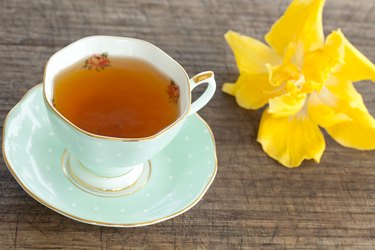
The plant roselle (Hibiscus sabdariffa) is a garden annual that grows to 7 feet high and almost as wide. The large leaves are dark green, but the rest of the plant -- leave veins, leaf stems, shoots, stems and branches -- are crimson purple. The bases of the bright yellow flowers can be dried and used to make a tea that is said to be high in antioxidants.
The Roselle Shrub
Video of the Day
Roselle is a popular garden plant in Florida and other areas in U.S. Department of Agriculture plant hardiness zones 8 through 11. It can be grown as a short-lived perennial in zones 10 through 11, and is often grown as an annual. Native to tropical Africa, the shrub is grown in the subtropics and tropics throughout the world.
Video of the Day
Roselle grows vigorously as a many-branched shrub taller and wider than most gardeners. The dark green leaves are about 6 inches wide. They are dissected into five narrow lobes. The yellow flowers appear in October. They look like classic hibiscus flowers, each one about 3 inches across with five petals. A fleshy, bright red calyx, about an inch in diameter, encloses the bases of the petals on the bottom of each flower. The calyces of roselle have been used to make juices, sauces, jellies, wines and pies. Today, they are often dried and used to make hibiscus tea.
Growing Roselle for Consumption
Roselle grows best in a full sun location in well-drained soil. Deep, fertile loam with some sand is the ideal mixture. Place the shrub where it has room to expand on all sides, because it is likely to grow wider than you imagine. It will need regular irrigation as well as light feeding with an organic fertilizer. Organic compost works well, or a small dose of any fertilizer you would feel comfortable using for vegetables. The shrub's cultural requirements are similar as those of the tomato plant.
As with tomatoes and other edible crops, you do not want to use pesticides that might leach into the flowers of the plant. Certainly, you must avoid using pesticides that are not organic within the final month before flowers arrive.
If you are growing roselle only to produce the calyces for tea, plant the shrubs in mid-May. Flowers will bloom in autumn, and the calyces will be ready to harvest in November and December.
Harvesting and Drying Roselle
You harvest the calyces when they turn red and the flowers begin to fade. Use garden shears to clip off the flowers. Remove the petals from the calyces. Then spread the calyces out to dry on a rack or a screen in a place where they do not get direct sunlight. As an alternative, you can use a dehydrator to dry the calices. When they are completely dry, remove the seeds from the inside of each calyx. Store the dried calices in a glass jar.
Make hibiscus tea by soaking 1 cup of dried calices in 8 cups of cold water. Let them soak for a few days. Strain out the flowers with a fine sieve. Add sugar, if desired. You can serve the tea heated in the microwave or chilled over ice.